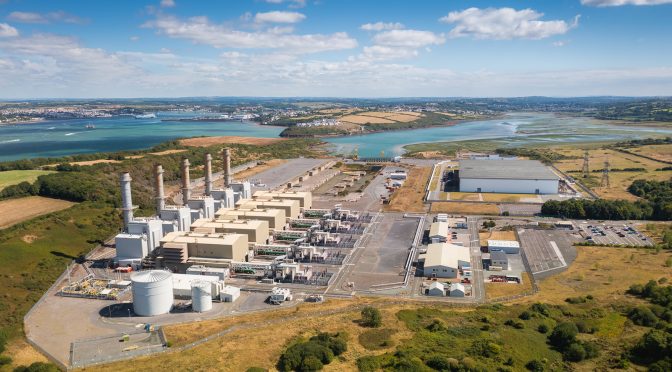At the site of the existing Pembroke Power Station, RWE will deploy new technologies including green hydrogen, carbon capture, large-scale battery storage and floating offshore wind from the Celtic Sea, coming together under a single project ‘Pembroke Net Zero Centre’ (PNZC).
A new report commissioned by RWE by Max Munday, Cardiff Business School, demonstrates the positive impact the company’s PNZC could have on the local economy and employment in Wales.
The report has highlighted how the project could boost Welsh economic activity with much of this focused on Pembrokeshire. Benefits are likely to accrue in phases, first during construction (which are ‘one-off’ benefits) and then during operation (i.e. in the long-term).
In the medium activity scenario, during construction (assumed to be 2023-2038) the report estimates that PNZC could support annual Welsh construction activity of £46m – £77m per annum (p.a.). Taking into account wider economic effects, it is estimated that total Welsh annual GVA connected to PNZC would be between £41m and £68m during construction, supporting between 900 and 1,500 jobs every year during this period.
The report goes on to demonstrate that, during operation, in the medium activity scenario, direct regional employment by RWE would double (an increase of 95 FTE on top of the existing 100 already employed at the Pembroke Power Station). Taking account of the whole economy effects of operational spending in the local economy, a total of 270 additional Welsh jobs would be supported, and a further £28m of GVA p.a. by 2040.
The site of the new venture is home to Pembroke Power Station which recently celebrated its 10th anniversary. The station currently directly employs around 100 people, with an annual operational and capital spend of over £60m, contributing an estimated c.£17m GVA p.a. to the local economy. However, as highlighted in the report, with the development of the PNZC and deployment of low carbon technology, this is set to increase even further.
In order to coordinate and maximise the opportunities these technologies offer RWE and Wales, and to collaborate with industrial partners and Welsh government, a new Director has been appointed.
Richard Little, who until very recently was the power station manager at Pembroke, has taken on the role as Director of the Pembroke Net Zero Centre (PNZC). He added his comments to the new report:
”The Pembroke plant has for a long time added far-reaching value into the Welsh economy creating and supporting high quality jobs in the region. With the future development of innovative low carbon energy technologies such as hydrogen, carbon capture, battery storage and floating wind from the Celtic Sea, the site has the potential to double GVA and almost triple job creation for Wales. Together these technologies will also support RWE in reaching its international goal to be carbon neutral by 2040.”
He continued, “What is clear is the site will play a key part in the energy transition over the coming years offering an enormous opportunity to suppliers, businesses and for employment across Wales.”
RWE is Wales’ largest energy generator and also the largest renewable generator with 12 operational sites including onshore and offshore wind, hydro and one of the most efficient gas plants in the UK – Pembroke.
PNZC has three distinctive pillars of development and implementation: large scale green hydrogen production, floating offshore wind from the Celtic Sea and the decarbonisation of the Pembroke Power Station itself, e.g. by fitting CCS and / or using low-carbon hydrogen as a fuel. RWE is siting the Net Zero Centre at Pembroke as it has all elements to the energy and industrial carbon trilemma: offshore wind accessibility, land for development of an electrolyser, grid and power connections, energy-intensive surrounding industries, and a gas power station at the centre.
For the full economic report on the Pembroke Net Zero Centre visit here and to see a video of the site here.


